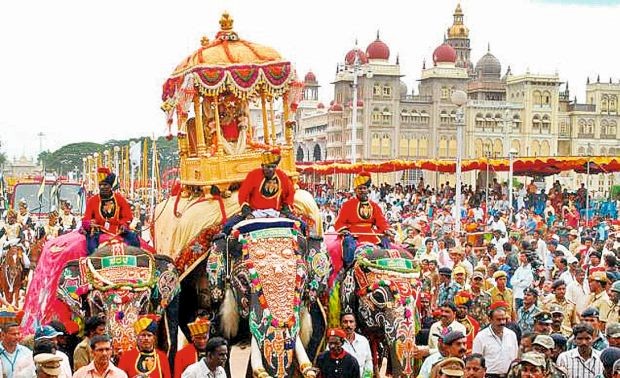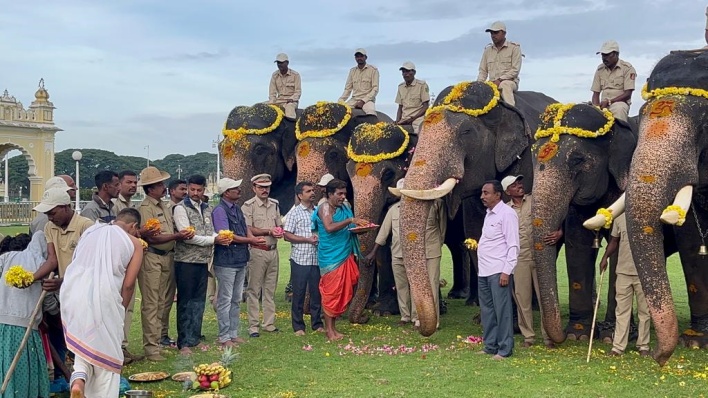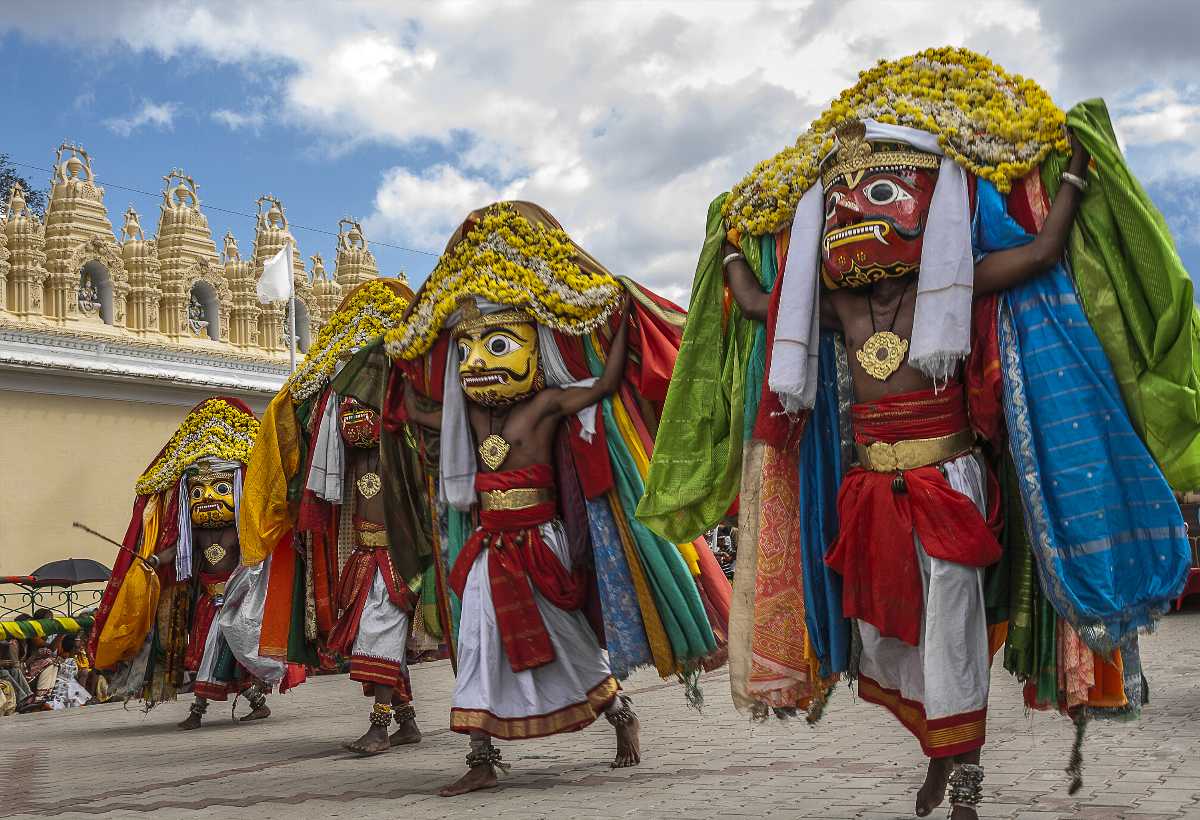Mysore Dasara
As the grand finale of Navaratri approaches, the majestic city of Mysore prepares for the much-anticipated Nadahabba, also known as the State Festival or Grand Dasara.

Situated in the heart of Karnataka, with its regal charm, Mysore is ready to welcome the magnificence and cultural richness of the Nadahabba. The culmination of vibrant Navaratri festivities sets the stage for a spectacular celebration, showcasing the city’s grandeur and splendour.
In Mysore, the tenth day of Navratri, known as Vijaya Dashami, holds profound significance. The city’s name, derived from ‘Mahishasurana Ooru’ or ‘Mahishuru‘ in Kannada, signifies the town of Mahishasura—the invincible and bovine asura from Hindu mythology. He met his defeat at the hands of the only thing Lord Brahma had not granted him protection against; the Goddess Chamundeshwari.
This nomenclature of the city traces back to Hindu legends celebrating the victory of good over evil, right over wrong, and virtue over vice on the tenth day-Vijayadashami. According to mythology, it was on this day that Goddess Chamundeshwari triumphed over the demon Mahishasura. The slaying of Mahishasura by the Goddess signifies the undeniable triumph of righteousness.
The Timeless Tradition-Jamboo Savari
On Vijayadashami, the streets of Mysore city come alive with a royal splash with the traditional Dasara procession, locally known as Jamboo Savari. The breathtaking wonderment in this magnificent spectacle is the gold-clad idol of Goddess Chamundeshwari, the Rajya Rani, majestically positioned in a golden Howdah atop a decorated elephant. Abhimanyu assumes the lead elephant role and has proudly carried the Golden Howdah at the Mysore Dasara since 2020.

Before the procession, the royal couple, the Queen of Mysore, and esteemed guests worship this idol. The majestic event unfolds as a vibrant and colourful affair, featuring numerous representations and cultural troupes following the elephant bearing the immensely revered idol.

Initially named Jambi Savari, the procession pinnacles at the Banni (Shami) tree on the city’s outskirts with a panjina kavayatthu (torch-light parade). According to mythology, the Banni tree played a vital role during the Pandavas’ exile, providing a concealment place for their weapons. In ancient times, kings performed rituals at the Banni tree, seeking its divine blessing as a victory in war.
This year commemorates the 413th anniversary of Mysuru Dasara. This tradition serves as a testament to the proud heritage of Karnataka.
The arrival of elephants in Mysore is a watchable delight in itself, occurring in groups about a month before the commencement of the main festivities. The elephants undergo dedicated practice sessions to prepare for the grand march on the final day.

Vibrant celebrations mark this period as villagers engage in folk dances, drum beats, and melodious songs to warmly welcome the majestic tusked creatures. This tradition echoes the regal traditions of the Mysore Maharajas, with villagers joyously greeting the sacred elephants throughout their designated route.
It’s a congruous blend of tradition, ritual, and community celebration, setting the stage for the grandeur of the upcoming festivities.
The Rich Legacy of Mysore Dasara
The roots of Dasara festivities extend back to the 14th-15th century during the Vijayanagar kings’ era. Although the precise origin of the celebration remains obscure, it played a significant historical role in the Vijayanagara Empire of the 14th century, known as Mahanavami. The outer wall of the Hazara Rama temple in Hampi bears relief artwork depicting the festivities during this period.

The Italian traveller Niccolò de’ Conti described Dasara as a ‘grand religious and martial event supported by royalty’. Durga, revered as the warrior goddess (sometimes called Chamundeshwari), took centre stage in the celebrations. Following the collapse of Vijayanagara to the Deccan Sultanates, Hindu celebrations ceased under Muslim rule.
However, the Wodeyars of Mysore, who established a kingdom in the southern parts of the Vijayanagara Empire, continued the Mahanavami (Dasara) festival. Raja Wodeyar I (1578-1617 CE) began this tradition in mid-September 1610 at Srirangapatna, marking the continuity of this vibrant cultural celebration.
Mysore’s Dazzling Tapestry
A conspicuous segment of the Nadahabba is the mesmerising illumination that transforms the heritage city. Mysore Palace, a nightly spectacle adorned with nearly 100,000 light bulbs, becomes a radiant symbol of brilliance and grandeur.

Not only the Palace but the entire city of Mysore, the only town where elephants take a walk, is adorned with dazzling lights that breathe life into its cultural essence every night of this ten-day festival. This spectacular display doesn’t limit itself to streets; it extends to embrace trees, arches, and historic buildings, weaving an exquisite atmosphere that blankets the entire city.

The residents of Mysore take great pride in holding their cultural heritage. In the mornings, the atmosphere is filled with the harmonies of classical Carnatic music drifting from behind wooden windows. Rangolis are meticulously drawn afresh every day, and as the evening descends, every corner of the city blazes to life with the warm glow of flickering oil lamps.
That’s not all; Mysore Dasara features many events that enchant residents and visitors. Culinary delights beckon at the Food Mela, while the University of Mysore Open Air Theatre becomes a hub of youthful exuberance during Yuva Dasara. Karnataka Kala Mandira transforms into a cinematic sanctuary with its Film Festival, and a local park bursts into bloom with the enchanting Flower Show. An expansive Exhibition sheds light on diverse aspects of culture and innovation.

In essence, Mysore Dasara is not merely a festival but a resounding cultural symphony of Karnataka’s timeless legacy. This celebration, weaving together tradition and culture, stands as a living testament to the indomitable spirit of a tradition that has transcended centuries. It is more than a spectacle; it is a devoted celebration, a rich expression of pridefulness, and a luminous beacon of Karnataka’s cultural grandeur that pulsates with the heartbeats of generations past and present.












Comments 1